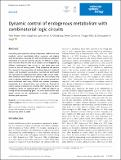Dynamic control of endogenous metabolism with combinatorial logic circuits
Author(s)
Moser, Felix; Espah Borujeni, Amin; Ghodasara, Amar Navin; Cameron, Douglas; Park, YongJin; Voigt, Christopher A.; ... Show more Show less
Downloade8605.full.pdf (1.077Mb)
PUBLISHER_CC
Publisher with Creative Commons License
Creative Commons Attribution
Terms of use
Metadata
Show full item recordAbstract
Controlling gene expression during a bioprocess enables real-time metabolic control, coordinated cellular responses, and staging order-of-operations. Achieving this with small molecule inducers is impractical at scale and dynamic circuits are difficult to design. Here, we show that the same set of sensors can be integrated by different combinatorial logic circuits to vary when genes are turned on and off during growth. Three Escherichia coli sensors that respond to the consumption of feedstock (glucose), dissolved oxygen, and by-product accumulation (acetate) are constructed and optimized. By integrating these sensors, logic circuits implement temporal control over an 18-h period. The circuit outputs are used to regulate endogenous enzymes at the transcriptional and post-translational level using CRISPRi and targeted proteolysis, respectively. As a demonstration, two circuits are designed to control acetate production by matching their dynamics to when endogenous genes are expressed (pta or poxB) and respond by turning off the corresponding gene. This work demonstrates how simple circuits can be implemented to enable customizable dynamic gene regulation.
Date issued
2018-11Department
Massachusetts Institute of Technology. Institute for Medical Engineering & Science; Massachusetts Institute of Technology. Department of Biological EngineeringJournal
Molecular Systems Biology
Publisher
Nature Publishing Group
Citation
Moser, Felix, Amin Espah Borujeni, Amar N. Ghodasara, Ewen Cameron, Yongjin Park, and Christopher A. Voigt. “Dynamic Control of Endogenous Metabolism with Combinatorial Logic Circuits.” Molecular Systems Biology 14, no. 11 (November 2018): e8605. © 2018 The Authors
Version: Final published version
ISSN
1744-4292